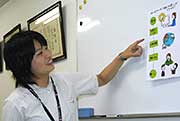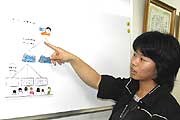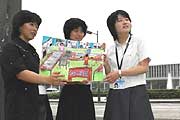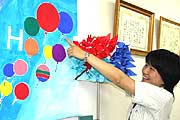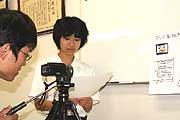August 6th, a memorial day for the world
Color the earth in a hue of peace
62 years ago, on August 6th, the first atomic bomb used against human beings was dropped on Hiroshima. Every year on that day, a large number of people visit Hiroshima to pray for peace. And, at the same time, an array of peace ceremonies and events are held in countries outside Japan, such as Denmark, Germany, Pakistan, Mongolia, the United States, Canada, and others. If the heart that prays for peace could have a color, the world would shine with the same hue.
The Peace Memorial Ceremony in Hiroshima is held to "console the souls of those who were lost due to the atomic bombing as well as pray for the realization of everlasting world peace." Last year, about 45,000 people attended the ceremony.
What can be done to encourage more young people to take part in this ceremony? How might we collaborate with people in other countries?
One minute of silent prayer at 8:15AM -What is the Peace Memorial Ceremony?
The Peace Memorial Ceremony has been known by this name since 1975. The first ceremony--held on August 5, 1946, one day before the first anniversary of the bombing--was called the Peace Restoration Rally and it took place at an old shrine near the present-day baseball stadium.
According to city officials, who organize the Peace Memorial Ceremony, the Mayor of Hiroshima became involved in the ceremony the following year, in 1947. That year it was called the Peace Festival and, until 1975, the name underwent many changes.
Last year's ceremony began at 8:00AM with the dedication of the registry of the victims. Flowers were then offered, followed by the tolling of the Peace Bell at 8:15AM with a minute of silent prayer. The ceremony also featured the Mayor's Peace Declaration, a speech by two children called "Our Commitment to Peace," and remarks by the prime minister of Japan. The event lasted 45 minutes.
"Our Commitment to Peace" was first included in 1995, the 50th anniversary of the bombing. The participants are 6th grade students in elementary school who are chosen by essay. The children then learn more about peace issues at Peace Memorial Museum before they start drafting their speech.
The Peace Memorial Ceremony typically includes about 45,000 participants. Since 1970, the number has generally ranged from 40,000~50,000 people. The city of Hiroshima estimates the number of non-Japanese participants at more than 1100. (Minako Iwata, 14)

|
Ideas to enhance The junior writers would like to make the Peace Memorial Ceremony more engaging for youth around the world. Towards this end, we came up with five ideas.(Yutaro Honkawa, 17) Click to watch each idea in action. |
 |
|
"Our Commitment to Peace" -youth from abroad take part, too |
||
|
In the current ceremony, representatives of the city of Hiroshima draft and read this speech. We propose that youth from abroad take part in this speech, too First, we would develop a website where everyone could contribute their ideas for the speech. And members of NGO groups might help in collecting ideas from children who live in refugee camps and have no access to the internet. An online vote is then held to choose the strongest ideas. Based on the outcome, a committee then uses these ideas to draft the speech. For example, if an idea involves poverty, the committee members would research it in depth to learn what youth might do to impact the problem and these thoughts would be included in the speech. Thus, "Our Commitment to Peace" could truly reflect the opinion of the world at large. | |
|
The ceremony is broadcast through the internet -in cooperation with Mayors for Peace | ||
|
Our second idea is to broadcast the ceremony to the world through the internet. The URL of the homepage could be delivered to the more than 1650 cities that make up the membership of Mayors for Peace. Then the video could be shown at schools in each city. If we assume that each city has 50 schools and each school has 100 students, more than 8 million children would watch the ceremony. (To overcome the language barrier, the broadcast could have simultaneous interpretation in English.) By broadcasting the ceremony around the world, the circle of people who pray for peace would grow wider. And the website would have a questionnaire soliciting people's impressions that could be taken into consideration for the next ceremony. |
|
|
|
A pedestrian zone on Peace Boulevard with booths -that share peace-related activities and inspire the public | ||
|
Establish a special pedestrian zone along Peace Boulevard in front of Peace Park. In this pedestrian zone, a variety of organizations from Japan and from abroad can have booths. Peace-related NGOs can share their activities in these booths and students could also present the findings of their peace education courses. These booths would enable people to express their ideas for peace in a number of ways. We believe this sort of pedestrian zone could stir people into working for peace. Moreover, the participating groups would have the opportunity to network and exchange ideas. And in the center of Peace Boulevard, on a special stage, public discussions between the mayor and youth, as well as peace concerts, could be held. | |
|
Mosaic made with folded cranes -involving countries around the world | ||
|
We propose creating a special mosaic. People around the world would send in pictures on the theme of peace and a panel of artists would choose one. That picture would be enlarged in black-and-white, divided into the same number of pieces as there are countries in the world, and the pieces are then assigned colors and sent to each country. Children around the world would then fold paper cranes to be combined into one large mosaic. On August 6th, representatives from each country would carry the cranes with them and these cranes would then be joined together to create the huge mosaic. If the full picture can't be completed, the empty spots would indicate that some countries weren't able to attend due to poverty or war. For all countries, it would be a good opportunity to consider how they can fulfill their part in order to complete the mosaic. |
| |
|
TV program -that enables youth to embrace the A-bomb survivors' cause | ||
|
Another idea is to produce a TV program which consists of reports and interviews involving youth who take part in the ceremony. For example, we might focus on a young person who runs a booth that shares messages of peace or interview other young people at the event. The purpose of this program would be to convey to older A-bomb survivors who cannot attend the ceremony that members of the younger generation are taking up their prayers for peace. And if the program is broadcast overseas, perhaps youth in other countries would be inspired to act in service of peace, too. | |
Music, dance, and floating lanterns... August 6th in the world
A variety of events centering on August 6th are held in many countries. We discovered 40 groups that organize events, but in fact, the total is probably ten times this number. We spoke with 14 groups about their activities and felt that an art exhibition featuring origami cranes, in Fuerth, Germany, and a peace concert held in Melbourne, Australia are particularly impressive.
We also asked these groups for suggestions regarding the Peace Memorial Ceremony in Hiroshima. Some of the ideas included: "more music and dance" (Rochester, USA); "organize a World Peace Conference in Hiroshima on August 6th" (Ulaanbaatar, Mongolia); and "hold an international art competition or international speech competition" (Kashmir, Pakistan).
Like us, people everywhere desire a more peaceful world. I hope we can collaborate with others on events such as these. (Kyoko Niiyama, 17)
Askov, Denmark (1) citizen group/religious group (2) August 6th (3) symposium (4) every year since 2005
Fuerth, Germany (1) local government (2) August 6th (3) decorate with peace messages from the world (4) every year since 1986 Samarkand, Uzbekistan (1) NGO (2) at the beginning of August (3) exhibition of photo panels, workshop with origami cranes, lectures (4) almost every year since 1986
Dhaka, Kaliganj, Boda--Bangladesh (1) NPO (2) August 6th (3) exhibition of photo panels, video screenings, symposiums (4) every year since 2001 Islamabad, Pakistan (1) citizen organization (2) August 6th (3) exhibition of posters, video screenings, making origami cranes, silent prayer (4) every year since 2002 Azad Jammu and Kashmir, Pakistan (1) NGO (2) August 6th (3) silent prayer, reading poems, and making origami cranes by children from elementary school to high school (4) since last year Ulaanbaatar, Mongolia (1) art school (2) August 6th (3) exhibition of photos of the bombing in Hiroshima and lecture about atomic bombs (4) every year since 1997
Wellington, New Zealand (1) citizen group (2) holiday near August 6th (3) floating lanterns, exhibition of photo panels, signing petitions (4) every year since 1997 Christchurch, New Zealand (1) citizen group (2) in the first part of "Peace Week" from August 5th to 12th (3) floating lanterns, peace march, reading poems, silent prayer, singing songs (4) every year since 1974 Melbourne, Australia (1) NPO (2) holiday around August 6th (3) peace concert, reading messages from atomic bomb survivors (4) every year since 2005
Minneapolis, USA (1) citizen group (2) August 6th (3) ceremony consists of a message from the Mayor of Hiroshima, a silent prayer, decorating with origami cranes, a peace concert (4) every year since 1985 Island of Tinian(Commonwealth of the Northern Mariana Islands/USA) (1) Local government (2) August 6th or 9th every year (taking turns, this year on August 6th) (3) memorial ceremony and monument for the late Mayor of Nagasaki (4) every year since 2003 Rochester, USA (1) citizen group (2) August 6th (in case of rain, it is postponed to August 9th) (3) speech by Mayor of Rochester, report on the late Mayor of Nagasaki, floating lanterns (4) every year since 1985 Halifax, Canada (1) citizen group (2) August 6th (3) chorus, silent prayer, play, exhibition of photo panels (4) every year since 2005 Note: (1) organizer (2) date (3) this year's program (4) history |
